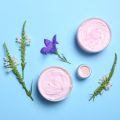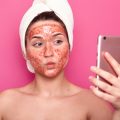1. Philosophy and Approach
When it comes to skincare, the philosophy behind Korean and American routines is quite different. Understanding these differences can help you figure out what works best for your skin type and lifestyle.
Korean Skincare: Prevention First
Korean skincare is all about prevention and consistency. The idea is to take care of your skin every day with gentle products so that problems like dryness, acne, or wrinkles are less likely to happen in the first place. Think of it like brushing your teeth—its a daily habit meant to keep your skin healthy long-term, not just when issues pop up.
The routines often include multiple steps (sometimes up to 10), focusing on hydration, nourishment, and barrier protection. It’s common to see ingredients like green tea, snail mucin, and centella asiatica that are soothing and non-irritating.
American Skincare: Quick Fixes & Active Ingredients
In contrast, American skincare often leans toward fast results using powerful active ingredients. People tend to look for quick fixes—like spot treatments or anti-aging serums—that show visible improvements in a short time. Products with retinol, AHAs (alpha hydroxy acids), and benzoyl peroxide are popular because they work quickly but can also be more intense or drying if overused.
This approach tends to focus more on solving specific problems after they appear, rather than preventing them from happening in the first place.
Key Differences at a Glance
| Aspect | Korean Skincare | American Skincare |
|---|---|---|
| Overall Philosophy | Prevention & long-term care | Treatment & quick fixes |
| Routine Style | Multi-step, gentle layering | Simpler, treatment-focused |
| Common Ingredients | Soothing botanicals (e.g., green tea, snail mucin) | Active chemicals (e.g., retinol, AHA/BHA) |
| Main Goal | Maintain healthy skin over time | Target visible skin issues quickly |
Both approaches have their benefits depending on your skin concerns and personal preferences. Whether youre into the calming rituals of Korean skincare or the fast-acting power of American formulas, knowing the “why” behind each method helps you make smarter choices for your routine.
2. Key Ingredients
When it comes to skincare, the ingredients used in Korean and American products reflect their unique beauty philosophies and cultural preferences. Lets break down how each region approaches skincare formulas—and why those differences matter for your skin.
Korean Skincare: Nature Meets Innovation
Korean skincare is known for its gentle yet effective approach, often relying on natural, plant-based, and fermented ingredients. The goal? To nourish and protect the skin barrier while achieving a radiant, dewy look (also known as “glass skin”).
Popular Korean Ingredients:
| Ingredient | Benefits |
|---|---|
| Snail Mucin | Hydrates, repairs skin damage, promotes collagen production |
| Ginseng | Anti-aging, improves circulation, brightens skin tone |
| Green Tea Extract | Soothes irritation, rich in antioxidants, controls oil |
| Centella Asiatica (Cica) | Calms inflammation, heals acne-prone skin, strengthens barrier |
| Fermented Ingredients | Boost absorption, enhance effectiveness of other ingredients |
American Skincare: Science-Backed Solutions
In contrast, American skincare tends to focus on strong actives with clinical backing. The emphasis is often on visible results—think anti-aging, acne treatment, and exfoliation—with dermatologist-recommended ingredients leading the way.
Popular American Ingredients:
| Ingredient | Benefits |
|---|---|
| Retinol (Vitamin A) | Reduces fine lines, boosts cell turnover, treats acne |
| AHAs (e.g., Glycolic Acid) | Chemical exfoliation, smooths texture, fades dark spots |
| Salicylic Acid (BHA) | Cleans out pores, targets acne, reduces inflammation |
| Niacinamide (Vitamin B3) | Evens skin tone, minimizes pores, strengthens barrier |
| Peptides | Supports collagen production, firms and plumps skin |
The Takeaway on Ingredient Philosophy
Korean skincare emphasizes gentle care with a preventative mindset—hydrating and calming the skin using nature-inspired formulations. On the flip side, American skincare often takes a corrective approach with potent actives designed to target specific concerns like wrinkles or breakouts.
If you’re building a routine or shopping for products, understanding these ingredient trends can help you choose what works best for your skin type and goals.

3. Routine and Steps
One of the most noticeable differences between Korean and American skincare lies in the daily routine—especially the number of steps involved. Let’s take a closer look at how these two skincare cultures structure their routines, and what each approach brings to the table.
Korean Skincare: A Multi-Step Ritual
Korean skincare is famous for its detailed, multi-step regimen that can include anywhere from 7 to 10 steps or more. This method focuses on prevention, hydration, and layering lightweight products to build up moisture and nourishment gradually. Each step has a specific purpose and is designed to work together to improve skin over time.
Typical Korean Skincare Steps:
| Step | Product Type | Purpose |
|---|---|---|
| 1 | Oil Cleanser | Dissolves makeup and sunscreen |
| 2 | Water-Based Cleanser | Cleanses sweat and dirt |
| 3 | Exfoliator (1–2x/week) | Removes dead skin cells |
| 4 | Toner | Balances pH and preps skin |
| 5 | Essence | Adds lightweight hydration and nutrients |
| 6 | Serum/Ampoule | Treats specific concerns like dark spots or fine lines |
| 7 | Sheet Mask (2–3x/week) | Nourishes and hydrates deeply |
| 8 | Eye Cream | Cares for delicate under-eye area |
| 9 | Moisturizer | Locks in all previous layers of hydration |
| 10 | Sunscreen (AM) | Protects against UV damage |
The Pros:
- Packed with hydration for long-term glow.
- Treats multiple skin concerns simultaneously.
- A mindful self-care experience.
The Cons:
- Takes more time daily.
- Might feel overwhelming for beginners.
- Certain steps can be costly when used consistently.
American Skincare: Streamlined and Practical
The American skincare approach tends to be more minimalistic. Many people stick to a 3- or 4-step routine, focusing on efficiency and targeting visible issues like acne, wrinkles, or sun damage. Active ingredients like retinol, AHAs, and vitamin C are often key players in American products.
Typical American Skincare Steps:
| Step | Product Type | Description/Purpose |
|---|---|---|
| 1 | Cleanser | Cleanses dirt, oil, and makeup from skin surface |
| 2 | Toner (optional) | Cleanses residue and preps skin for treatment products |
| 3 | Treatment Serum or Cream (e.g., Retinol/Vitamin C) | Addresses concerns like aging or pigmentation |
| 4 | Sunscreen (AM) / Moisturizer (PM) | Sunscreen protects during day; moisturizer hydrates at night. |
The Pros:
- Saves time—great for busy lifestyles.
- Easier on the budget with fewer products.
- Packs a punch with potent active ingredients.
The Cons:
- Might miss out on deeper hydration benefits.
- Certain actives can irritate sensitive skin if not balanced properly.
- Lack of layering can lead to dryness or imbalance over time.
No matter which routine you prefer, understanding the philosophy behind each can help you make better choices for your skin type and lifestyle. Whether you love the indulgent ritual of Korean skincare or the efficient simplicity of an American routine, both have unique benefits worth exploring.
4. Product Innovation and Packaging
One of the most noticeable differences between Korean and American skincare is how each market approaches product innovation and packaging. While both aim to deliver effective skincare, their strategies often reflect different consumer expectations and cultural influences.
Korean Skincare: Creative Formulas and Fun Experiences
Korean beauty brands are widely recognized for pushing the boundaries when it comes to textures, application methods, and ingredient combinations. From jelly-like moisturizers to bubbling masks and essence-infused sheet masks, K-beauty focuses on making skincare not only effective but also enjoyable. This playful approach often appeals to younger audiences and skincare enthusiasts who love trying new things.
Key Features of Korean Skincare Innovation:
- Unique textures like water-gel creams, sherbet cleansers, and ampoules
- Creative application methods (e.g., cushion compacts, sleeping packs)
- Multi-step routines with targeted treatments
- Trend-driven ingredients (e.g., snail mucin, fermented extracts)
American Skincare: Focused, Functional, and Backed by Science
In contrast, American skincare tends to emphasize simplicity, effectiveness, and science-backed formulations. Packaging is often minimalistic and designed to communicate key benefits clearly—think pump bottles with clean labels or tubes with dermatologist-recommended claims. Rather than offering a sensory experience, many U.S. brands focus on clinical results and ease of use.
Key Features of American Skincare:
- Streamlined products with multitasking functions
- Clean, no-fuss packaging focused on clarity
- Active ingredients backed by dermatological research (e.g., retinol, niacinamide)
- Shorter routines centered on efficiency
Side-by-Side Comparison
| Aspect | Korean Skincare | American Skincare |
|---|---|---|
| Product Texture | Lightweight gels, essences, unique formats | Creams, serums with a clinical feel |
| Packaging Style | Cute, colorful, innovative containers | Sleek, minimalistic designs with scientific appeal |
| Approach to Ingredients | Trendy + natural ingredients (e.g., green tea, centella) | Dermatologist-approved actives (e.g., salicylic acid) |
| User Experience | Sensory-focused and fun rituals | Straightforward and results-driven routines |
The difference in innovation and packaging really shows how Korean skincare leans into novelty and enjoyment while American skincare values straightforward efficacy. Both have their strengths—it just depends on what you’re looking for in your skincare journey.
5. Consumer Mindset and Beauty Standards
When it comes to skincare, cultural values and beauty ideals play a huge role in shaping consumer habits. Both Korean and American skincare industries are influenced by what their societies view as beautiful, and this directly impacts the types of products people buy and how they use them.
Korean Beauty Ideals: The Pursuit of Glass Skin
In Korea, the ideal look is often described as “glass skin” — a term that refers to skin that appears poreless, luminous, and almost translucent. This beauty standard emphasizes hydration, layering lightweight products, and maintaining a youthful glow. Korean consumers are very proactive about skincare, often starting routines at an early age and following multi-step regimens religiously. There’s also a strong focus on prevention rather than correction.
American Beauty Ideals: Individualism and Anti-Aging
In the U.S., beauty ideals tend to center around individuality and self-expression. Instead of striving for one uniform ideal like glass skin, Americans are more focused on personalized skincare goals — whether its acne control, anti-aging, or hyperpigmentation treatment. Products are often marketed for their performance and results, especially in fighting signs of aging such as fine lines or sagging skin.
Key Differences in Consumer Mindsets
| Aspect | Korea | United States |
|---|---|---|
| Main Beauty Ideal | Glass skin (clear, glowing, hydrated) | Youthful but individualized beauty goals |
| Approach to Skincare | Preventive, holistic, multi-step routines | Targeted treatments, efficiency-focused |
| Cultural Influence | Collectivism; trends driven by K-pop/K-drama idols | Individualism; emphasis on personal choice and uniqueness |
| Popular Product Types | Toners, essences, ampoules, sheet masks | Retinol creams, serums with active ingredients like AHAs/BHAs |
| Age Group Focus | Younger consumers start early with skincare education | Strong anti-aging market targeting 30s+ |
Cultural Impact on Purchasing Behavior
Korean consumers are more likely to follow beauty trends promoted by celebrities or influencers en masse. This leads to quick adoption of new ingredients or techniques across all age groups. Meanwhile, American consumers prioritize effectiveness and often rely on dermatologist-recommended products or scientific claims before making purchases. While both markets value good skin health, their paths toward achieving it differ greatly based on cultural perspectives on beauty.
Understanding these differences can help you better navigate which products suit your needs — whether youre drawn to the meticulous layering of K-beauty or prefer the results-driven approach of American skincare.


